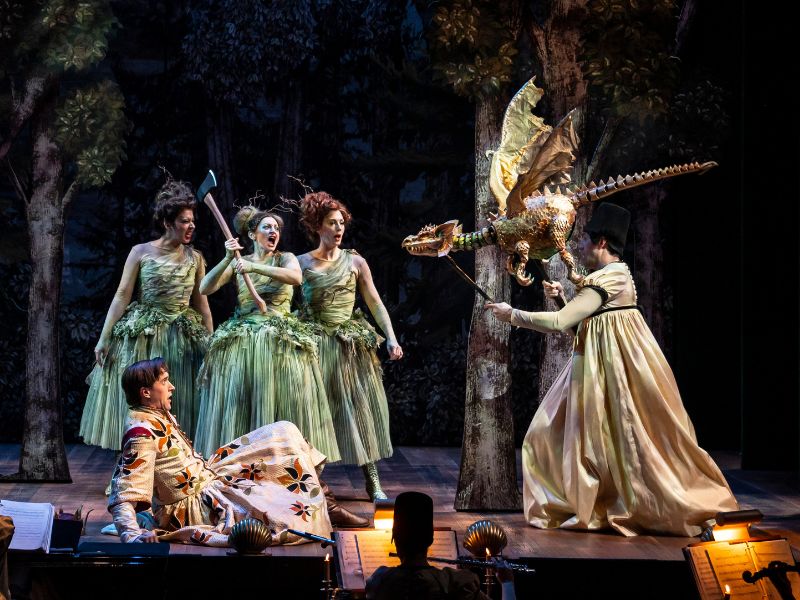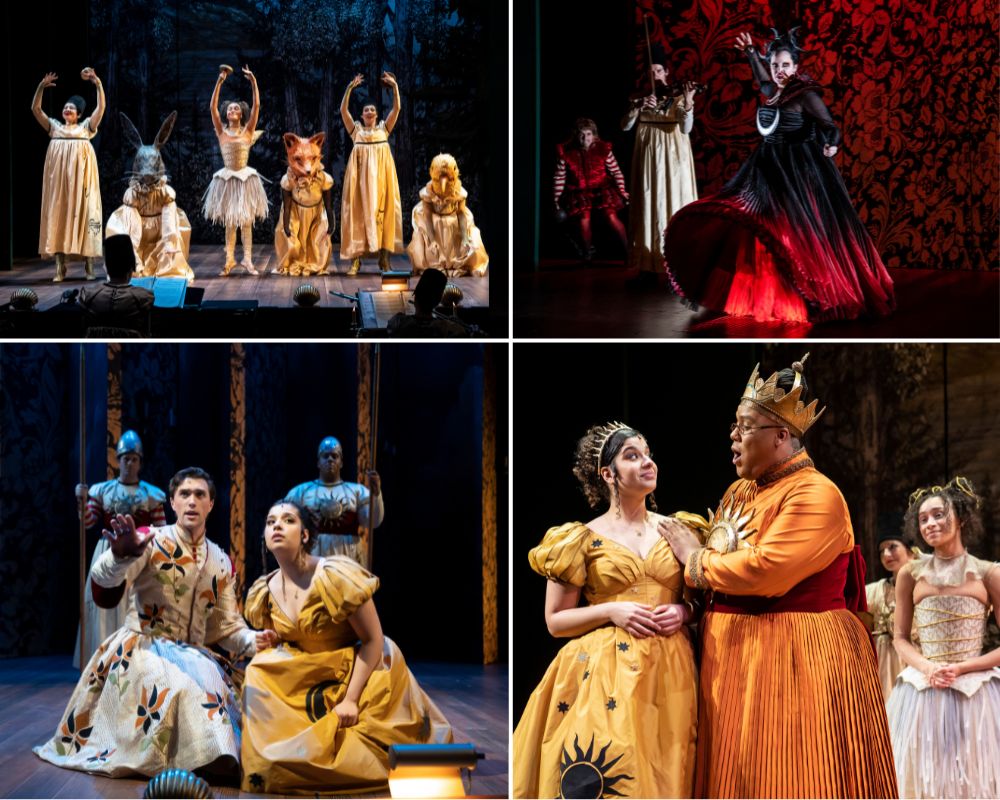Mozart — profound and sublime, yes, but also the most playful of composers. Director Mary Zimmerman leans into that playfulness in Shakespeare Theatre Company’s delightful The Matchbox Magic Flute. Condensing Mozart’s final opera into a more intimate space, using 10 singing actors and five musicians, and altering and modernizing the English-language libretto (often with very contemporary laugh lines), Zimmerman creates a winning musical theater piece that grabs the audience and never lets go.
This is very much an ensemble show. There is a romantic couple, Tamino (Billy Rude) and Pamina (Mariene Fernandez). There is a comic couple, Papageno (Shawn Pfautsch) and Papagena (Lauren Molina). There is a pair of antagonists, the Queen of the Night (Emily Rohm) and Sarastro (Keanon Kyles). A trio of ladies (Molina, Tina Munoz Pandya, and Monica West) comment on and take part in the proceedings. They bring Tamino his magic flute and Papageno his magic bell. There is an inept, comic villain, Monostatos (Russell Mernagh). Not least, there is The Spirit, primarily a movement role (Reese Parish), who gracefully, with a light touch, introduces many of the scenes, sometimes helping the audience follow the proceedings with hand-held signs.

Everyone carries off their role with aplomb. With a light tenor voice that wouldn’t be out of place in a Gilbert and Sullivan role like Ralph Rackstraw, Rude creates the sort of prince that every fairy tale deserves. Fernandez sings of her heartbreak in a gorgeous mezzo aria in the second act.
Pflautsch is a comic whirlwind as Papageno, incessantly verbally twittering like the birds he tries — with little success — to catch, until he finds his Papagena in Act Two. Their famous Act Two duet has never been funnier or more endearing, or indeed more birdlike.
The deeper psychological side of the show lies with Sarastro and the Queen of the Night. Rohm, displaying suberb coloratura chops in her two arias, brings depth to a character who at first seems a sympathetic mother seeking her daughter’s rescue from Sarastro, whom she portrays as tyrant. But the more we see of the Queen, the more she resembles other great musical theater mothers who desperately try to prevent their daughters from living their own lives: think the Witch in Into the Woods or Mama Rose in Gypsy.
In contrast to the Queen’s darkness, Sarastro is a “sun king.” He exercises paternal power over Tamino, Pamino, and Papageno. If it be tyranny, it is of a benevolent kind. His tests — silence for Tamino, heartbreak for Pamina, fire and water for them both, and selfless generosity for Papageno — are designed to teach the younger characters what is necessary to mature beyond romantic attraction to achieve genuine love. Kyles brings the necessary gravitas to the role.
In his program essay, the always excellent STC dramaturg Drew Lichtenberg draws a telling parallel between Sarastro and the Queen and Oberon and Titania from A Midsummer Night’s Dream. Both, he notes, preside by virtue of magic, “by turns beneficent and foreboding, placed in mutual opposition but forming an eventual concord.” Like Shakespeare, Mozart illuminates the ambiguity of characters and their relationships.
Identified as a “Moor,” and laden with the racial stereotyping endemic in Mozart’s era, Monostatos has long been a problematic character in the original opera. Fortunately, Zimmerman’s adaptation deftly avoids the problem, leaving us simply with Mernagh’s effectively amusing physical awkwardness as his plotting repeatedly comes to naught.

Besides fitting the scale of the production, the five-piece band, led by Laura Bergquist, gives great clarity to the score, allowing the audience to hear the delicacy as well as the strength of Mozart’s writing. Zimmerman gives various members of the band — all of whom are in spirit-like costumes, decorated with musical notes — the chance to join the characters on stage for some of the second-act scenes. Doing so adds to the sense of ensemble that pervades the entire production.
Zimmerman weaves the cast together with a dense, flexible physical production. Todd Rosenthal’s set features trees that the cast smoothly moves about, vertical panels that turn to reveal woodland scenes, clouds, or a tapestry backdrop, and a false proscenium reflecting Zimmerman’s concept of private theatres in old European palaces and chateaux. All the pieces move smoothly, leading seamlessly from one scene to another. On one occasion, Papageno, in a petulant moment, turns all the panels and brings on trees in a one-man scene change.
Other effects create memorable moments. Glitter flies from Papageno’s magic bell and showers down on the entire cast at the conclusion. Red petals fall from the fly space as Tamino and Pamina endure Sarastro’s trial by fire. Small panels of Hokusai-like waves, pushed back and forth by other cast members, depict their trial by water. A cloth banner with musical notes flies up from the stage floor as the sun rises.
Anna Kuzmanic’s costumes add vibrancy to the characters. Tamino is dressed in a kind of elaborate tunic — fit for a fantasy prince — white with colorful flower designs. Papageno, woodland denizen that he is, wears brown and turquoise. Most spectacularly, the Queen wears a dress, black on top, red in the lower skirt, illuminated from within by a brighter red light in one scene. As befits a Sun King, Sarastro’s costume is emblazoned with a golden sun motif. There are wonderful masks — a bird, a fox, a bunny — to add to the fun.
One of the hallmarks of any top-notch production is its attention to detail. Here The Matchbox Magic Flute excels. Each gesture, each movement, is intentional, tied to a specific line or musical note or other character’s reaction. A particularly striking example is in the Queen’s first-act aria, during which some part of Tamino’s body reacts to each note in the Queen’s vocal ornamentation. It’s as hilarious in its execution as it is admirable for its skill.
From children’s books onward, magic in the traditional sense is an essential element in fairy tales. But there’s real magic in this production, the kind that happens in a theater when every element comes together to delight and amaze and enchant an audience. The Matchbox Magic Flute is not to be missed.
Running Time: Two hours and 20 minutes, including one intermission.
The Matchbox Magic Flute plays through June 16, 2024, at Shakespeare Theatre Company’s Michael R. Klein Theatre (formerly the Lansburgh) – 450 7th Street NW, Washington, DC. Tickets ($35–$175) are available at the box office, online, or by calling (202) 547-1122. STC offers discounts for military servicepeople, first responders, senior citizens, young people, and neighbors, as well as rush tickets. Contact the Box Office or visit Shakespearetheatre.org/tickets-and-events/special-offers/ for more information. Audio-described and ASL-interpreted performances are also available.
The Asides program for The Matchbox Magic Flute is online here.
COVID Safety: All STC spaces are mask-friendly — meaning all patrons, masks and unmasked, are welcome. Read more about Shakespeare Theatre Company’s Health and Safety policies here.
The Matchbox Magic Flute
Adapted and directed by Mary Zimmerman
Based on the opera by Mozart
Produced in association with Goodman Theatre
CAST (in alphabetical order)
Marlene Fernandez: Pamina
Keanon Kyles: Sarastro
Russell Mernagh: Monostatos
Lauren Molina: Papagena, Lady
Tina Muñoz Pandya: Lady
Reese Parish, The Spirit
Shawn Pfautsch: Papageno
Emily Rohm: Queen of the Night
Billy Rude: Tamino
Monica West: Lady
UNDERSTUDIES
Dario Amador-Lage: u/s Tamino
Ann Delaney: u/s Papagena/Lady, u/s Lady, u/s The Spirit
Devin DeSantis: u/s Papageno, u/s Monostatos
Nathan Karnik: u/s Sarastro
Emilie Lynn: u/s Queen of the Night, u/s Lady
Katherine Riddle: u/s Pamina
CREATIVE TEAM
Director and Adaptor: Mary Zimmerman
Music Adapted and Arranged by: Amanda Dehnert and Andre Pluess
Music Director: Amanda Dehnert
Set Designer: Todd Rosenthal
Costume Designer: Ana Kuzmanić
Lighting Designer: T.J. Gerckens
Sound Designer: Andre Pluess
Wig & Hair Designer: Charles G. LaPointe
Casting: Lauren Port, CSA
Resident Casting Director: Danica Rodriguez
Flying Effects provided by ZFX
Production Stage Manager: Laura Smith
Assistant Stage Manager: Marne Anderson




